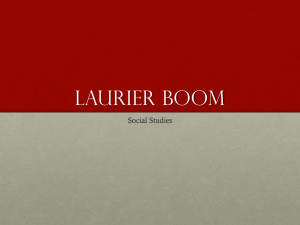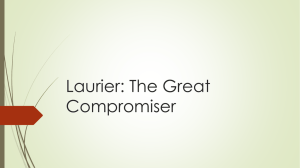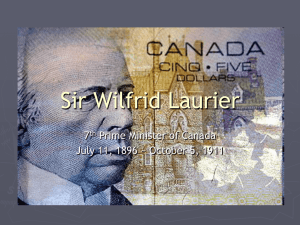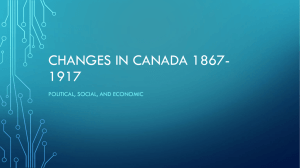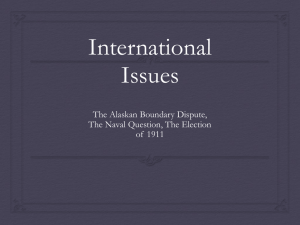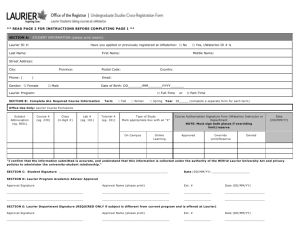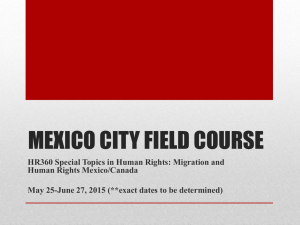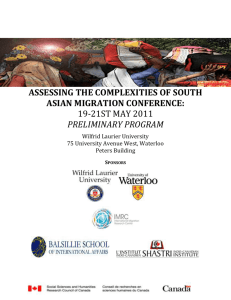The Great Transformation
advertisement
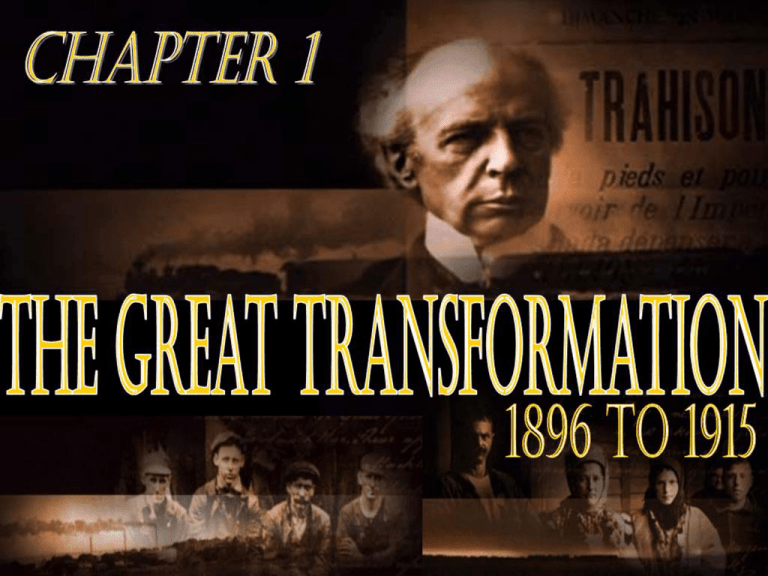
• July 1897 – word spreads – Gold in the Klondike • Rush of U.S. prospectors and would be minors – global recession – many unemployed • The first major obstacle – the Chilcote Pass – miners were required to arrive with 6 months of supplies. • April 1898 – major winter storm/avalanche kills 60 • Hub of activity – biggest Canadian city west of Winnipeg due to 30,000 US arrivals. • • • • Miners arrived to find most stakes claimed. Unemployment was high. Men turn to gambling, drinking, drugs. Women turn to “entertainment,” prostitution • Summer of 1899 – rush over – 50% of population leaves in weeks. • Born and raised in Quebec countryside – excels at Law school. • Gains popularity in Ottawa due to charismatic ways. • Spring of 1896 – runs for Prime Minister in election and wins. • Believes strongly that French and British Canadians can work together. • Almost immediately, Laurier is faced with the problem of French and Catholic schools being closed in Manitoba. • Premier doesn’t want them – French minority feels they are a right. • Laurier able to reach compromise – schools only in areas where numbers of French are large enough – agreement favors English – anger in Quebec. • 1897 – Laurier knighted while attending Queen Victoria’s Diamond Jubilee – 60th year as Queen of England. • Promises Canada will always be there for England. • 1899 – Dutch settlers in South Africa start a land dispute with English soldiers – Boer War begins. England wants Canada’s help. • English Canada supports the British and wants to send help. • French Canadiens see it as British imperialism – reject it outright. • Laurier reaches a compromise – volunteers may go, but England pays all expenses. • Henri Bourassa – a French Canadien Liberal – openly opposes Laurier’s compromise. • Laurier does not take him seriously – Bourassa quits Liberals. • Laurier believes in settling the Prairies. • Posters in Europe offer 160 acres of free land in the Last Best West. • Laurier’s Minister of the Interior – Clifford Sifton, wants “stalwart” peasants with previous farming experience – looks to eastern Europe. • Hardships awaited new arrivals. • Disease such as scarlet fever, lack of access to supplies, no roads, and un-cleared lands meant lots of work before crops could be harvested. • Crop yields were worth the sacrifice, and this immigration wave becomes the largest in Canadian history, bringing Icelandic, Ukrainian, Dukabhor, German, Polish, Menonite and Jewish cultures to Canada. • Cape Breton Island – Marconni designs the world’s first wireless transmission system. • First wireless radio telecast to Europe – 1902. • Alexander Graham Bell – creator of the telephone, builds the “Silver Dart” • A much improved airplane design, it is able to fly farther, faster. • Hydro power harnessed at Niagara Falls • Affordable electricity promised for everyone. • Electricity modernizes Toronto – Department Stores, Factories. • Urbanization becomes a major force. • 1912 – Montreal reaches 500,000 pop. – tripled in size in 20 years. • 2/3 of Canadian wealth controlled by 100 families – the Van Horne’s, Molson’s, Burke’s and Allan’s. • Extreme income disparity creates worker unrest – tailors strike against 59 hour work week in 1907 and win – 49 hour work week created. • Conditions in Montreal are very poor – high infant mortality – life expectancy 50 years. • Progress has a price – labor unionism is growing to support workers rights. • English banks not lending money to French Canadien farmers – Credit Union created. • By 1904 – the Prairie are transformed – new towns and settlements all according to Laurier’s plan. But rail is not keeping up. Farmers want their own government. • Laurier promises to address the problem if reelected in 1904. • True to his word, after re-election in 1904, he adds two provinces. • Bourassa is not satisfied with Laurier’s vision, however. • Wants a stronger French voice in the West. • When this looks impossible, he creates the Nationaliste – and rallies educated Canadiens to the cause. • Nellie Mooney becomes a leader in pushing for Women’s Suffrage – allowing women to vote in Canada. • This movement quickly gets tied into women’s drive for Prohibition – the illegalization of alcohol – due to high rates of abuse. Women’s Temperance Union is formed. • The Temperance Union even criticizes women’s fashion trends. • 1916 – Manitoba women granted right to vote and run for office. • By 1911, the rapid wave of immigration has had a profound social effect on Canadian cities – especially Winnipeg – highest percentage of foreign born residents. • Their crowded and run down living conditions lead to feelings that immigration must be stopped. • Some, such as James Woodsworth, a Methodist minister, feel that these people should be welcomed, and conditions should be improved. • Woodworth moves to the poor neighborhoods and gets to know these people – writes Strangers Within Our Gates – wants to educate, and eliminate terms such as “foreigners” and hyphenated Canadians. Book sells well. • Similar sentiments were growing in BC, where Chinese CPR workers, who had moved into the cities (after completion), set up Chinatowns for support, were seen suspicious, solitary people who lowered wages. • 1885 - $50 head tax imposed – raised to $500 in 1903 • Continuous Passage Law – all ships had to sail directly to Canada • Sept, 1907 – Asiatic Exclusion League meets in Vancouver – three days of riots – Chinatown vandalized. 1923 – Chinese banned outright. • 1906 – Britain launches the Dreadnought – first all ‘big-gun’ warship. Arms race with Germany begins. • 1910 – Laurier’s 13th year as PM – British want more warships – British Canadians say YES!, Canadien Nationalists say NON! • As a compromise – Laurier creates the NAVAL SERVICES BILL – creating a Canadian navy that can be sent to aid the British in emergencies. Bourassa furious. • British Canadians call it a ‘Tin Pot Navy’ • Summer of 1910 – Laurier tours the West he helped build. • Farmers want Free Trade with US – better markets and cheaper goods • Travels to Prince Rupert on CNR – Canada’s 2nd transcontinental railway. • 1911 – negotiates Free Trade with US (Reciprocity). • Critics raise old fears that Canada will become a US annex. • US agrees – wants Canada. • Old supporters turn against Laurier. • Robert Borden runs against Laurier in 1911 election. Bourassa rallies French Canadiens against Laurier. • Sept. 1911 - Borden wins election. • 1914 – Tramp steamer carrying 376 passengers from India arrives in Vancouver Harbor – held on board for 2 months. • HMCS Rainbow ordered to escort ship out of Canadian waters – violated Continuous Passage Law. Symbolic as end of Laurier era. • September of 1914 – war breaks out in Europe. • Border declares Canadian support for England. • Canada proves to be one of England’s greatest supporters – sending an initial group of 31,000 volunteers. • Germany swiftly moves through neutral Belgium • Canadian troops see first action holding German’s out of France at Ypres – 1st gas attack – Canadians suffer heavy losses. • Canadian medical soldier – John McCrae writes Flander’s Fields about the horrors he witnesses in the early phases of the Great War.
